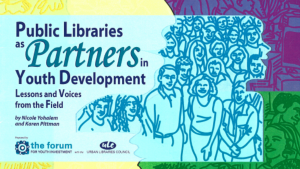
On August 21, The Washington Post reported on an inner-city community organization that served young people in one of the District’s poorest all-African-American neighborhoods. Stories about youth-serving organizations appear in the Post frequently. This one caught my eye because it ran on the front page. It held my attention because it epitomized one of the biggest challenges facing youth work in this country — the isolation of uniqueness.
The headline read “Teens Fear Losing SE Center’s Lifeline.” Teen Life Choices (TLC) a youth center that sees about 265 inner-city youth each month, was slated to close at the end of September. Its ending was dictated in a faxed letter from D.C. officials that “praised the center but said they could no longer afford it.”High drama? Perhaps. But not new to veterans in youth services. Unfortunately, it will appear repeatedly, with different actors, until we drastically lower the uniqueness quotient in youth work.
This story appeared on the front page not as a case study of the crisis facing community based youth services, but because community members and young people, angry about the hypocrisy and indifference, called a news conference. But it was a B-section article in the A-section. What do I mean?
There was no context
TLC is one of dozens of youth-serving agencies in D.C. and thousands in the U.S. that offers disadvantaged youth much-needed supports, opportunities and services. Statistics were offered on the escalating rates of youth problems, but none on the number, diversity, stability, or reach of youth programs. The article reported that the center was funded to do prevention programming (e.g., tutoring conflict resolution, pregnancy prevention). It captured the essence of youth development programming in its portrayal of an afternoon at the center (kids rehearsing plays, playing Monopoly, writing poetry, working with staff) and its quotes from young people. It did not, however, help the reader understand how youth work weaves these two goals — prevention and development — together.
There was no investigative analysis
TLC’s $275,625 budget was cut abruptly. There were no data comparing cuts in youth services to cuts in other services. No data on the costs and benefits of youth work. No comments on the logic of patchwork prevention funding for core community programs. Most important, there was no big picture painted — the D.C. human services department lost $150 million from its budget. How many other programs faced similar ends? What was the picture in other neighborhoods in the city? Nor was there any critical within-sector comparison. Was Teen Life Choices, in fact, a good youth program? Its members suggest that it stood out, proclaiming it to be better than others still standing. But the article does not paint a clear picture of what a good youth center is, other than through the voices of youth and TLC’s youth workers.
There were no expert voices
The story, like many feature stories, was a story of one program told in the voices of the youth and staff. There were no quotes from youth researchers, youth work experts, government officials. No statements from or references to larger actions being taken by local or national advocacy organizations. No expert voices called upon to respond to the pointed question posed by one member: “How can you keep kids out of trouble if you keep closing something that benefits them?”
Funders, policy makers, and the public perhaps most easily moved into action by portrayals of individual programs like Teen Life Choices of Midnight Basketball. But, it does as much for the bigger issues facing youth work as profiles of a single family living in a car do for the broader issue of homelessness. And, as the recent Crime Bill debates demonstrated vividly, being singled out, or as Midnight Basketball was, costs as well as benefits. This single front-page article on Teen Life Choices should have been an opener to a series of A-section articles on the state of youth services in D.C. and the country. Educate the media? Yes, but we brought this one-program-at-a-time-feature section coverage on ourselves. How many of us, given the opportunity to talk about our programs, tithe even 10 percent of the time talking clearly and urgently about the entire field? Uniqueness has its place, but unity is what is needed. Where were TLC’s sister organizations? Conversation with TLC’s director, Helena Valentine suggests that they were as absent in real life as they were in the article.
We welcome your contributions to the topic. Please reach out to talkwithus@kpcatalysts.com if you’d like to join to the discussion.
Article was originally published in

Pittman, K. (1994, November/December). “Strength in Unity.” Washington, DC: The Forum for Youth Investment. A version of this article appears in November 1, 1994



No comment yet, add your voice below!